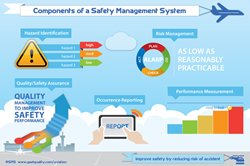SOAR+
is a computer-based safety of operations audit, risk assessment and resolution of safety issues (ROSI) process supporting E-IOSA, IASA, ISBAO as well as SAIs, EPIs, DOD, ICAO, regulatory compliance, NetJets, internal QA/evaluation, and/or custom audit protocols. SOAR+ raises the bar by risk-ranking audit standards, then reporting results in an intuitive, executive-friendly format that establishes a means for quantifying returns on investment (ROI) in safety.
SOAR+ is imminently configurable; e.g. A CASE version of SOAR+ is set to be installed at a major US based Maintenance & Repair Operation (MRO) soon; providing services to Pratt & Whitney, the US Air Force and UPS among others. SOAR+ is also under consideration to support the US Department of Transportation’s (DOT’s) Federal Transit Authority (FTA) implementation of safety management systems (SMS) in US municipal transit and rail operations. Could also work for airports, shipping, and hospitals it: wherever safety and compliance is linked to performance.
SOAR “AAP” is a flight data monitoring (FDM)-based safety of operations-assurance, risk management, airman-ship assurance and asset protection utility incorporating the identical ROSI process as SOAR+. Unconstrained by traditional flight operations quality assurance (FOQA) paradigms, SOAR AAP optimizes the use of aircraft flight data recorders, the so-called “Black-Boxes,” before the crash: to optimize operations, training, and to actually prevent accidents by making practical application of information that is traditional used only to conduct forensic inquiry…after the fact.
SOAR+ Attributes –
- Audit standards can be derived and/or imported into SOAR+ from any source: from ICAO, host country regulations, to internal airline oversight, quality control and quality assurance processes.
- A gap analysis and corrective actions tool exemplary of highest standards in SMS.
- Supports SAIs, EPIs, specific regulatory requirements (SRRs), as well DOD and Enhanced-IOSA requirements.
- Also available as an IOSA-attainment sub-routine providing a sequential guide to air, ground and maintenance operators in achieving and maintaining IATA registration.
- Standards and findings are risk-ranked in advance of the audits, and after, to guide in prioritizing effective action plans.
- Reports are normalized to 100% to facilitate effective communications with non-technical stakeholders, and to
- Establish a basis for quantifying return on investments in safety.
- Both SOAR+ and SOAR AAP fill significant lapses in virtually all existing SMS computer-based utilities,
- Can be integrated into existing SMS software.
- There are Enterprise versions,
- And versions capable of supporting-
- Mobile devices,
- Laptop PCs and
- “Cloud-based” access.
- The ROSI process includes prioritization of findings on the basis of safety and/or business, political and economic concerns, supporting unparalleled root cause analysis, safety risk assessment (SRA) and corrective actions implementation, validation, and assurance processes.
- And versions capable of supporting-
• Indeed, SOAR+/SOAR APP may represent a credible foundation for what can best be described as “Next-generation SMS.”
SOAR+ is deliberately configured to be useful measuring the attainment of standards in virtually any environment. For example, SOAR+ could be a useful means to measure attainment of implementation standards in Ebola prevention and treatment procedures, methods and protocols, to report results in an imminently intuitive executive-friendly format, to measure the risk of failure to implement complete and comprehensive corrective measures, to conduct safety risk assessments on proposed corrective measures, to document approval of an accountable individual before deploying proposed corrective actions, to verify and validate implementation, controlling performance creep by means of a continuously renewable improvement process, and to quantify return on investment in health and safety of the population. We would need to dissect Ebola prevention and treatment protocols to identify standards and then deploy auditors to record their observations in the SOAR+ safety of operations, risk assessment and resolutions of safety issues utility.

 For the first time in 30 years, ICAO are set to release a new Annex – Annex 19 – that pulls together current safety management practices and future expectations for facilitating safety risks that exist in our lands and skies.
For the first time in 30 years, ICAO are set to release a new Annex – Annex 19 – that pulls together current safety management practices and future expectations for facilitating safety risks that exist in our lands and skies.